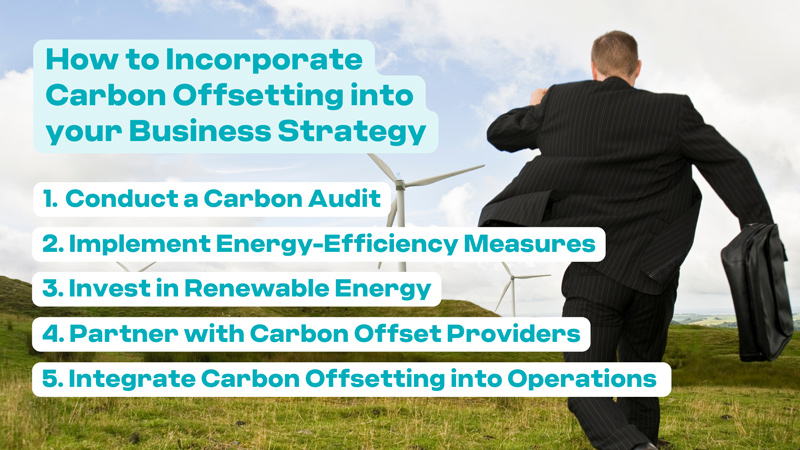Businesses are under growing pressure to act and decrease their carbon footprint as the world struggles to cope with the effects of climate change. One impactful approach to achieve this is through carbon offsetting, which involves making up for emissions produced by the company by funding projects that reduce emissions elsewhere. In this article, we explore the various ways that businesses can incorporate carbon offsetting into their strategy and avoid ballooning their carbon footprints.
How do Businesses Incorporate Carbon Offsetting into their Strategy?

Conduct a Carbon Audit
Conducting a carbon audit is a crucial first step in incorporating carbon offsetting into a corporate strategy. It involves calculating the amount of carbon emissions that your company produces, and identifying areas where emissions can be reduced. A comprehensive carbon audit should cover all aspects of the company’s operations, from energy consumption to supply chain and transportation.
A carbon audit typically involves several stages. The first stage is data gathering, which involves collecting information on the company’s energy use, transportation, waste management, and other relevant factors. The second stage is data analysis, where the gathered data is analysed to identify areas where emissions can be reduced. The final stage is reporting, where the audit’s findings are documented and presented to stakeholders.
Once the audit is complete, the company can use the findings to set goals for reducing emissions and calculate the quantity of carbon offsets needed to meet those goals. This information can then be used to develop a carbon offsetting plan that aligns with the company’s broader sustainability goals. In addition to reducing the company’s carbon footprint, a well-executed carbon audit can also identify opportunities for cost savings and operational efficiency improvements.
Implement Energy-Efficiency Measures
To directly reduce your company’s carbon footprint, consider implementing energy-efficiency measures as a strategy. Energy efficiency measures aim to reduce the amount of energy consumed by a business, resulting in reduced overall greenhouse gas emissions. By adopting energy-efficient measures, businesses can not only reduce their carbon footprint but also save money on their energy bills.
One of the most effective energy efficiency measures is installing insulation to reduce heat loss. Insulation acts as a barrier that slows down the movement of heat between the inside and outside of a building. By insulating walls, floors, and ceilings, businesses can reduce the amount of energy needed to heat and cool their premises. This, in turn, reduces the amount of greenhouse gas emissions produced by the building.
Another effective energy efficiency measure is implementing a power management system. This involves using software to automatically shut down non-essential devices during off-hours, such as computers, printers, and other office equipment. By reducing energy use during these periods, businesses can save money on their energy bills and reduce their carbon footprint.
Upgrading lighting and appliances to more energy-efficient models is also an effective energy efficiency measure. Lighting and appliances are responsible for a significant portion of a company’s energy consumption. By upgrading to more energy-efficient models, businesses can reduce their energy consumption and carbon footprint. For example, LED lights use up to 80% less energy than traditional incandescent bulbs and last up to 25 times longer.
Invest in Renewable Energy Projects
Investing in renewable energy is not only beneficial for the environment but can also provide economic benefits for businesses. Renewable energy sources such as solar, wind, and hydro are becoming increasingly cost-competitive with traditional energy sources such as coal and gas. By investing in renewable energy, businesses can reduce their energy costs and improve their long-term financial sustainability.
One way businesses can invest in renewable energy is by purchasing renewable energy certificates (RECs). RECs are certificates that represent the environmental benefits of one megawatt-hour of renewable energy generation. By purchasing RECs, businesses can support the generation of renewable energy and offset their carbon emissions. This not only helps the environment but can also improve a company’s brand reputation and appeal to environmentally conscious consumers.
Another way businesses can invest in renewable energy is by installing on-site renewable energy systems, such as solar panels or wind turbines. These systems can provide a reliable source of renewable energy for the company and reduce its reliance on traditional energy sources. Additionally, excess energy generated by these systems can be sold back to the grid, providing an additional source of revenue for the business.
According to a study by the International Renewable Energy Agency (IRENA), the cost of renewable energy technologies such as solar and wind has decreased significantly in recent years, making them more accessible to businesses. Additionally, the study found that renewable energy technologies can provide significant economic benefits, including job creation and improved energy security. Therefore, investing in renewable energy can be a win-win for both the environment and a business’s bottom line.
Partner with Carbon Offset Providers
Another useful strategy in reducing your business’ carbon footprint is to partner with carbon offset providers. Carbon offset providers offer businesses the opportunity to fund projects that reduce emissions in other parts of the world. These projects can include renewable energy, energy efficiency, reforestation, and other initiatives that reduce greenhouse gas emissions. By partnering with carbon offset providers, businesses can help to reduce their carbon footprint while supporting sustainable development projects in other regions.
When selecting a carbon offset provider, it is essential to do thorough research to ensure that the provider’s projects are credible and transparent. The provider should have a clear and rigorous process for measuring, verifying, and reporting the impact of their projects. Additionally, the projects should be certified by independent third-party organizations such as the Gold Standard or Verified Carbon Standard. These certifications ensure that the projects meet high environmental and social standards and provide real, measurable emissions reductions.
Partnering with a carbon offset provider can also provide businesses with a range of co-benefits beyond emissions reductions. For example, many carbon offset projects support sustainable development initiatives in the communities where they are located. These initiatives can include job creation, education, and healthcare programs, which can have a positive impact on local communities’ wellbeing. Additionally, by supporting renewable energy and energy efficiency projects, businesses can help to reduce their reliance on fossil fuels and reduce their exposure to volatile energy prices.
Integrate Carbon Offsetting into Operations
Integrating carbon offsetting into business operations is a crucial step towards sustainability. By setting goals and regularly reporting on progress, businesses can establish themselves as environmentally conscious and take meaningful steps towards reducing their carbon footprint. Incorporating carbon offsetting into operations involves making it a core component of the company’s sustainability strategy.
Integrating carbon offsetting into operations requires a long-term commitment to reducing the carbon footprint of a business. Companies that take this approach may set goals for emissions reductions and carbon offsetting, and regularly report on their progress to stakeholders. This approach can help businesses to establish a positive reputation with clients, staff, and investors by demonstrating a commitment to sustainability.
Additionally, businesses can consider other ways to integrate carbon offsetting into operations. For example, they may choose to work with suppliers that prioritize sustainability or switch to more environmentally friendly products and packaging. These actions can reduce a company’s overall carbon footprint and contribute to a more sustainable future for all.
Start Your Business’ Carbon Offsetting Strategy with Us
Carbon offsetting is a powerful tool that businesses can use to take action on climate change and reduce their carbon footprint. Businesses can have a significant impact on climate change and help to create a more sustainable future by completing a carbon audit, implementing energy-saving measures, investing in renewable energy, cooperating with carbon offset providers, and incorporating carbon offsetting into daily operations. Offset your carbon emissions now via our portfolio of verified carbon offset projects.




